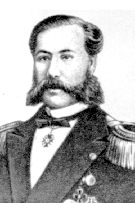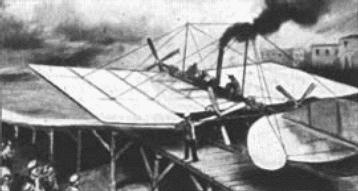

Alexandre Fedorovich Mozhajskij
| High
Ranked Sea Fleet Officer
Mozhajskij decided in 1854 to develop a flying machine with fixed wing and driven by propellers. Series of experiments with spring-powered models allowed to gain (very limited) support from Military Department, built the world first full-size heavier-than-air powered aircraft and try to fly it.Aircraft took off, but underpowered (50kg/hp) machine was too unstable in the air. There is no record about sustained flight... The scheme of Mozhajsky airplane was far ahead of contemporary full-scale aircraft. In 1876, A.F.Mozhajskij built a spring-powered aircraft model, which was capable of performing takeoff and flight from the ground without assistance. Speed was up to 15km/h with payload (sailor's dagger). After series of demonstrations, late 1876, A.F.Mozhajskij applied for financing (from Military Department) to continue experiments with bigger models. More demonstrations were performed in 1877, and designer concluded that its time to built full-size 'apparatus'. This proposal was rejected. |
|

(1825-1890) |
 |
Aircraft had all elements classic monoplane: fuselage ("the boat"), wide wing ("parachute"), 4-wheel landing gear, tail included tailplane and fin. It was 1880 when A.F.Mozhajskij got lucky enough to get money to order steam engines in England ("Apbeker-son and Hamkens"). Engines were designed with Mozhajskij's participation. 20hp (300rpm) engine weight was 47.6kg, 10hp (450rpm) - 28.6kg. Other elements of the steam engine totalled 82kg, what was a record at the time. In 1881 another attempt to gain financial support failed, this time rejected by tsar Alexandre III himself. This pushed designer to start aircraft assembly by himself. In 1882 A.F.Mozhajskij got a permit to use military field in Krasnoe Selo near St.Petersburg, behind high fence and in tight secrecy... but under open sky, affected by rainy weather and winds. |
Aircraft was finished in same 1882, but it took a long time to fix all problems, mostly in its propulsion system. Propellers introduced strong vibrations. Mechanical complications and persisting financial shortages made aircraft much heavier than was initially planned. At the same time several improvements were introduced. To make takeoff easier, aircraft was launched from inclined ramp. There is little information about flights, except few fragments. Most of them describe attempt, when aircraft took off, but slide to the side and crushed (probably injuring the pilot). Other refers to the first flight, when aircraft damaged undercarriage and "parachute" (i.e. wing) hitting the fence. As well the fence was as high as 5-6m - does it mean that aircraft was in air? A.F.Mozhajskij tried the most obvious move - to put copies of the most powerful engine in his possession (20hp) on each propeller. Those were ordered on Obukhov Steelworks (St.Petersburg), but not finished before designer's death in 1990. Anyway, this was a first powered heavier-than-air aircraft capable to make it of the ground with a pilot.
| ŠAvStop Online Magazine Contact Us Return To News |